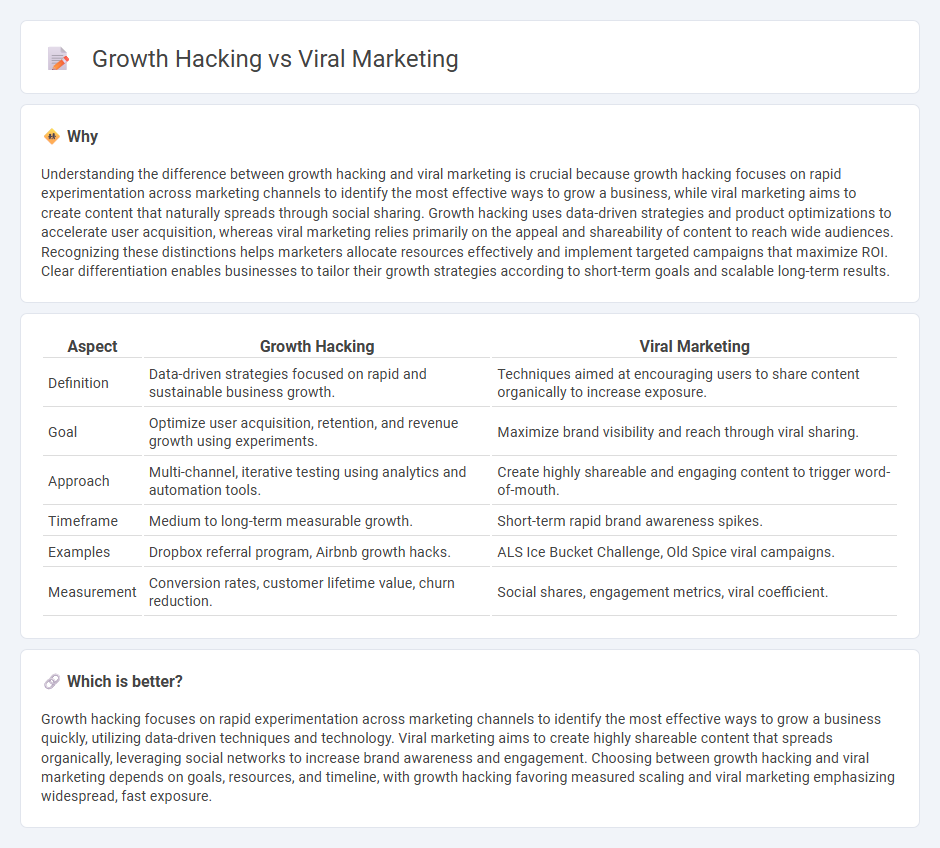
Growth hacking leverages data-driven strategies and rapid experimentation to optimize customer acquisition and business growth with minimal budget. Viral marketing focuses on creating shareable content that spreads organically through social networks to maximize brand exposure and engagement. Explore the nuanced differences and applications of these dynamic marketing approaches to elevate your business strategy.
Why it is important
Understanding the difference between growth hacking and viral marketing is crucial because growth hacking focuses on rapid experimentation across marketing channels to identify the most effective ways to grow a business, while viral marketing aims to create content that naturally spreads through social sharing. Growth hacking uses data-driven strategies and product optimizations to accelerate user acquisition, whereas viral marketing relies primarily on the appeal and shareability of content to reach wide audiences. Recognizing these distinctions helps marketers allocate resources effectively and implement targeted campaigns that maximize ROI. Clear differentiation enables businesses to tailor their growth strategies according to short-term goals and scalable long-term results.
Comparison Table
| Aspect | Growth Hacking | Viral Marketing |
|---|---|---|
| Definition | Data-driven strategies focused on rapid and sustainable business growth. | Techniques aimed at encouraging users to share content organically to increase exposure. |
| Goal | Optimize user acquisition, retention, and revenue growth using experiments. | Maximize brand visibility and reach through viral sharing. |
| Approach | Multi-channel, iterative testing using analytics and automation tools. | Create highly shareable and engaging content to trigger word-of-mouth. |
| Timeframe | Medium to long-term measurable growth. | Short-term rapid brand awareness spikes. |
| Examples | Dropbox referral program, Airbnb growth hacks. | ALS Ice Bucket Challenge, Old Spice viral campaigns. |
| Measurement | Conversion rates, customer lifetime value, churn reduction. | Social shares, engagement metrics, viral coefficient. |
Which is better?
Growth hacking focuses on rapid experimentation across marketing channels to identify the most effective ways to grow a business quickly, utilizing data-driven techniques and technology. Viral marketing aims to create highly shareable content that spreads organically, leveraging social networks to increase brand awareness and engagement. Choosing between growth hacking and viral marketing depends on goals, resources, and timeline, with growth hacking favoring measured scaling and viral marketing emphasizing widespread, fast exposure.
Connection
Growth hacking and viral marketing are interconnected strategies focused on rapid business expansion by leveraging innovative, cost-effective techniques to maximize user engagement and acquisition. Viral marketing fuels growth hacking efforts by creating highly shareable content or campaigns that encourage organic dissemination across social networks, amplifying brand visibility and customer base. Both approaches rely on data-driven experimentation and analytics to optimize conversion rates and accelerate scalable growth.
Key Terms
**Viral Marketing:**
Viral marketing leverages compelling content and social sharing to rapidly expand brand awareness and customer base, relying on organic user engagement across social media platforms. Successful viral campaigns often incorporate emotional appeal, incentives, or unique storytelling to encourage widespread sharing and enhance visibility. Explore our detailed insights on viral marketing strategies to maximize your brand's viral potential.
Word-of-Mouth
Viral marketing leverages organic word-of-mouth to rapidly amplify brand awareness through shareable content, creating exponential reach without heavy advertising expenditure. Growth hacking employs targeted experiments and data-driven strategies to optimize user acquisition, retention, and referral mechanisms, often integrating viral elements to enhance word-of-mouth effects. Explore how combining these approaches can maximize customer engagement and business growth.
Shareability
Viral marketing focuses on creating highly shareable content that rapidly spreads through social networks, leveraging emotional triggers and user engagement to amplify brand visibility. Growth hacking emphasizes innovative, data-driven strategies and iterative experimentation to optimize shareability and accelerate user acquisition efficiently. Explore our detailed comparison to understand which approach best fits your marketing goals.
Source and External Links
Viral Marketing: What It Is and How It Works + Successful Examples - Viral marketing is a strategy designed to make content spread rapidly among users, relying on creativity and emotional engagement to create an exponential sharing effect without large advertising budgets, distinguishing it from traditional advertising by its active audience participation.
Viral marketing - Wikipedia - Viral marketing uses existing social networks to promote products by encouraging consumers to spread information like a virus, primarily on social media, often unpredictably and organically through word of mouth and network effects rather than paid distribution.
Viral Marketing: Advantages, Disadvantages, Examples and FAQs - Viral marketing leverages captivating, share-worthy content distributed through social media and word-of-mouth to reach large audiences rapidly, driven by the content's innate appeal that motivates voluntary sharing within personal networks.
 dowidth.com
dowidth.com